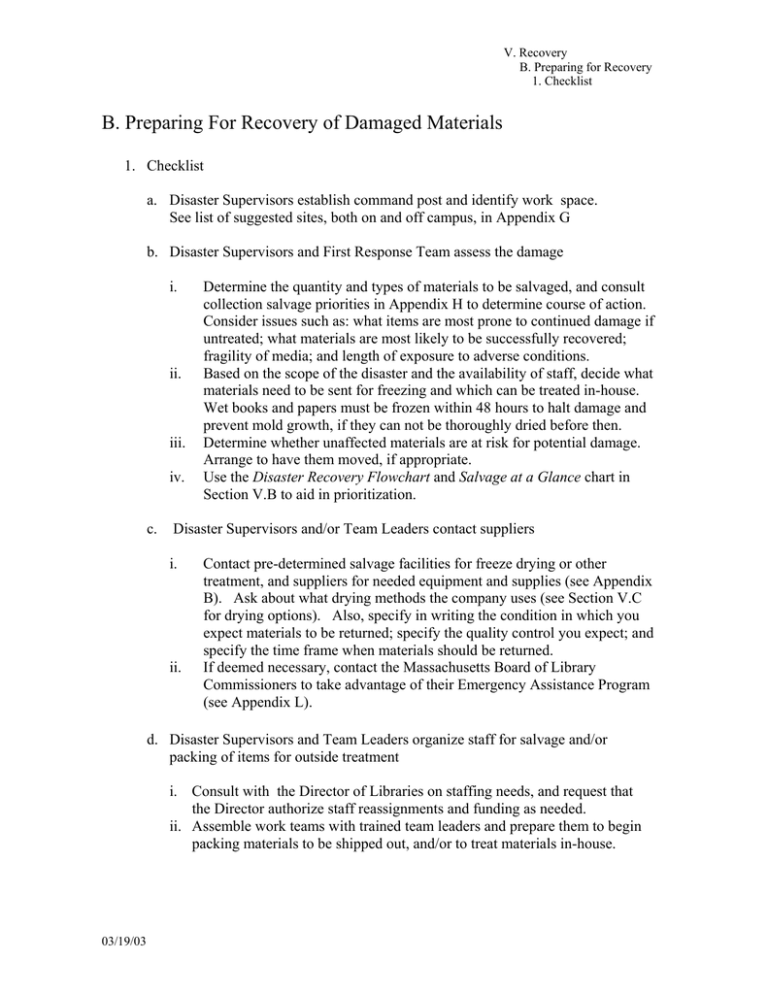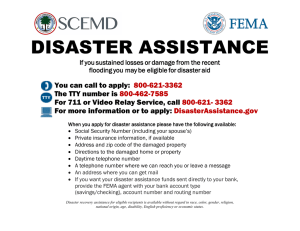B. Preparing For Recovery of Damaged Materials
advertisement

V. Recovery B. Preparing for Recovery 1. Checklist B. Preparing For Recovery of Damaged Materials 1. Checklist a. Disaster Supervisors establish command post and identify work space. See list of suggested sites, both on and off campus, in Appendix G b. Disaster Supervisors and First Response Team assess the damage i. ii. iii. iv. c. Determine the quantity and types of materials to be salvaged, and consult collection salvage priorities in Appendix H to determine course of action. Consider issues such as: what items are most prone to continued damage if untreated; what materials are most likely to be successfully recovered; fragility of media; and length of exposure to adverse conditions. Based on the scope of the disaster and the availability of staff, decide what materials need to be sent for freezing and which can be treated in-house. Wet books and papers must be frozen within 48 hours to halt damage and prevent mold growth, if they can not be thoroughly dried before then. Determine whether unaffected materials are at risk for potential damage. Arrange to have them moved, if appropriate. Use the Disaster Recovery Flowchart and Salvage at a Glance chart in Section V.B to aid in prioritization. Disaster Supervisors and/or Team Leaders contact suppliers i. ii. Contact pre-determined salvage facilities for freeze drying or other treatment, and suppliers for needed equipment and supplies (see Appendix B). Ask about what drying methods the company uses (see Section V.C for drying options). Also, specify in writing the condition in which you expect materials to be returned; specify the quality control you expect; and specify the time frame when materials should be returned. If deemed necessary, contact the Massachusetts Board of Library Commissioners to take advantage of their Emergency Assistance Program (see Appendix L). d. Disaster Supervisors and Team Leaders organize staff for salvage and/or packing of items for outside treatment i. Consult with the Director of Libraries on staffing needs, and request that the Director authorize staff reassignments and funding as needed. ii. Assemble work teams with trained team leaders and prepare them to begin packing materials to be shipped out, and/or to treat materials in-house. 03/19/03 V. Recovery B. Preparing for Recovery 1. Checklist e. Team Leaders arrange for transportation, supplies and equipment i. Arrange for the delivery of materials and equipment (boxes, garbage bags, newsprint, book trucks, labels and pens, flat trucks, etc.) as needed to the disaster site from on- or off-site sources ii. Arrange for transportation of boxed damaged items from the disaster site to the recovery location iii. Assemble any additional supplies or equipment (tables, fans, extension cords) needed for on-site salvage. f. Disaster Supervisors confer with Director of Libraries to provide information for College Relations to issue a statement on the disaster i. College Relations should always be consulted before reporting anything to the media. ii. Any library staff questioned by the media should briefly explain what they are doing. Sound organized and in control, and continue working. Suggest that the person speak with the Director of Libraries, who will be in communication with College Relations. iii. Library staff should never divulge information regarding the value of materials, personal injuries, and whether or how long a building may need to be closed. 03/19/03


